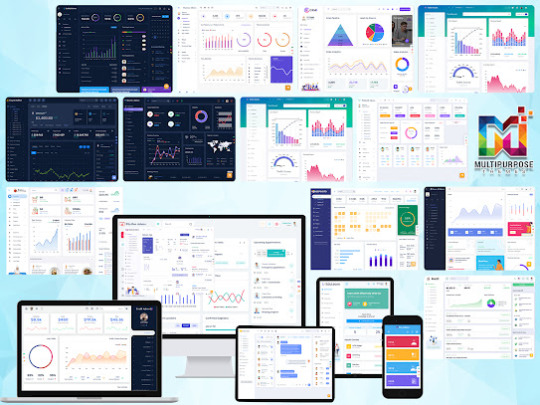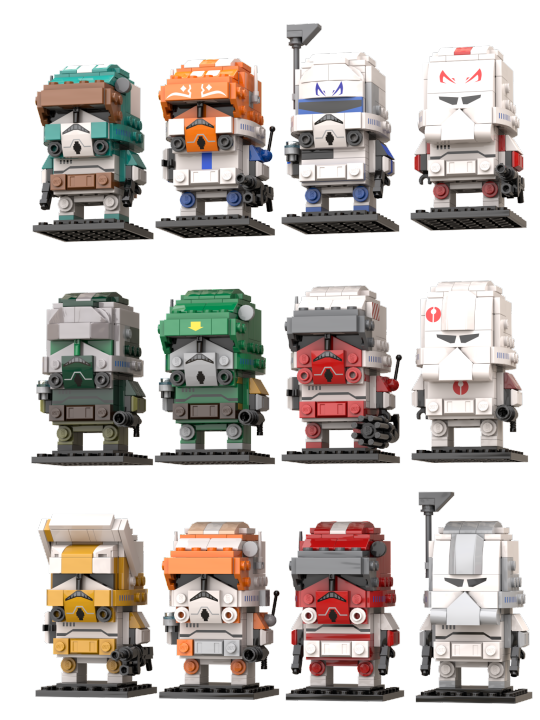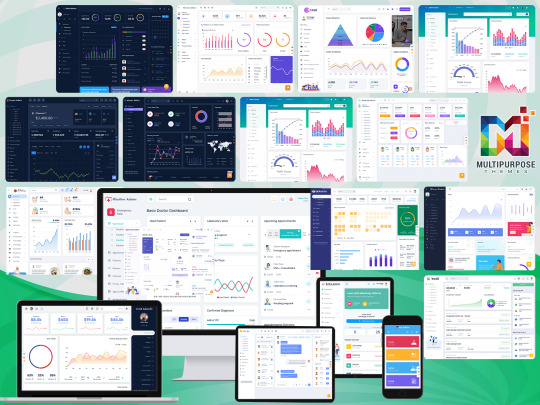#Software Dashboard Design
Explore tagged Tumblr posts
Text
A Comprehensive Guide to Bootstrap Admin & Dashboard Templates

Dashboard Templates built with Bootstrap provide a quick and efficient way to create backend interfaces and web apps. With pre-built components, customizable layouts, and easy integration, a Bootstrap admin template helps developers skip repetitive coding tasks and focus on business logic. This comprehensive guide explores the key benefits of using Bootstrap for admin templates and dashboards.
Why Choose Bootstrap for Admin Templates
Built on top of the popular Bootstrap framework, Admin Dashboard UI Kit inherit several advantages:
Responsiveness Out-of-The-Box: With Bootstrap's mobile-first approach, components automatically adapt for desktop, tablet, and mobile screens. This saves ample development time.
Cross-Browser Consistency: Bootstrap templates render seamlessly across all modern browsers like Chrome, Firefox, Edge etc. There are no worries about CSS overrides.
Easy Customization: Variables and mixings allow easy styling changes sitewide. Tweaking colors, fonts, sizes to match brand requirements is straightforward.
Component Reuse: Bootstrap's UI library can be reused across templates and pages. No need to code repeating elements like cards, alerts, modal popups etc.
Continuous Updates: Bootstrap's open-source community steadily improves and extends functionalities. Admin templates built on Bootstrap allow leveraging the latest developments.
With these benefits, Bootstrap streamlines building admin backends and control panels, reducing cost and time-to-market.
#Dashboard Templates#Admin Dashboard UI Kit#Bootstrap UI Kit#Software Dashboard Design#Bootstrap UI framework#Responsive Web Application Kit#Bootstrap Admin Panel
0 notes
Text
Struggling to create clear & insightful Master Dashboard Design? Learn best practices & design principles in our ultimate guide. Boost data communication & decision-making with effective dashboards. Our guide shows you how!
For More info - executive project dashboard
0 notes
Text
Mastering React Native Components and UI Development: A Comprehensive Guide

Introduction:
This thorough primer to React Native, a potent tool for creating cross-platform mobile applications, is yours to peruse at your leisure. The React Native environment will be covered in this blog article, along with its benefits and step-by-step directions for building your first Custom software application in React Native.
Facebook created the open-source React Native technology for mobile applications. It enables programmers to construct mobile apps for the iOS and Android platforms using JavaScript and React. Programmers can now construct mobile applications using the same code and guiding principles as React web applications thanks to React Native, an extension of the popular JavaScript toolkit React.
React Native has completely changed how we create cross-platform mobile applications by providing a streamlined JavaScript and React development environment. Every React Native app's components and user interface (UI) are what give the app its overall appearance and functionality. In this blog post, we will discuss recommended practices for UI development and delve into the world of React Native components. Whether you're a novice or a seasoned developer, this thorough manual will arm you with the skills necessary to design gorgeous and effective user experiences with React Native.
1. Components of React Native to Understand:
It's crucial to understand the concept of components if you want to create reliable applications with React Native. First, we'll go into great detail about components, including what they are, how they work, and the many types that are available in React Native.
2. Reusable Component Development:
As React Native enables you to effectively design large user interfaces by composing smaller, self-contained parts, creating reusable components is a crucial component of the development process. In this section, we will examine how to develop reusable components in React Native.
3. Identifying Reusable Elements:
The first step towards creating reusable components is to identify UI elements or functionalities that appear frequently throughout your app. From buttons and headers to cards and lists, recognizing these repeating elements will form the basis of your reusable components.
4. Setting Up the Component File:
Once you've identified the reusable element, create a new component file with a.js extension in your React Native project. Organizing components in separate files ensures a clean and structured codebase.
5. Importing Dependencies:
In the component file, begin by importing necessary dependencies, such as React and React Native components. These dependencies will be essential for building your reusable component.
6. Building the Reusable Component:
Depending on your requirements, create either a functional or class component. For simplicity, we will focus on functional components. Design the component with flexibility in mind, allowing it to accept props for customization and dynamic behavior.
7. Utilizing Props for Customization:
One of the key features of reusable components is their ability to adapt to various scenarios. Utilize props to pass data and event handlers to your component, making it customizable and interactive. This enables you to reuse the same component with different configurations throughout your app.
8. Exporting the Component:
To use the component in other parts of your app, export it using export default. Exporting the component allows you to import and render it wherever needed, promoting code reusability.
9. How to Use the Reusable Component:
Once the reusable component has been developed, import it into your app and use it within other components. This method provides uniformity throughout your application and streamlines the ERP development process.
10. Extension and Modification of Reusable Components:
You might need to change or expand the functionality of your reusable components as your program develops. Learn how to modify current components while maintaining backward compatibility to prevent needless refactoring.
Styling in React Native:
1. A Deep Dive into CSS and Flexbox:
Learn the art of styling in React Native using CSS-like properties and Flexbox layout. We'll cover the basics of styling components, handling responsive designs, and creating visually appealing user interfaces.
2. Handling User Input with React Native Components:
From buttons and text inputs to checkboxes and dropdowns, we'll explore various React Native components that handle user input. We'll discuss best practices for designing intuitive user interfaces and handling user interactions.
3. Building Complex UIs with Composing Components:
Combining simple components to create complex UIs is a crucial skill in React Native development. We'll dive into the technique of composing components to build sophisticated user interfaces with ease.
4. Navigation and React Navigation:
Seamless navigation is essential for a great user experience. We'll introduce React Navigation, a popular library for handling navigation in React Native apps, and explore different navigators and navigation patterns.
5. Styling Best Practices for Performance:
Optimizing your app's performance is crucial for ensuring a smooth user experience. We'll discuss performance-oriented styling techniques and tips to reduce rendering time and improve your app's responsiveness.
6. Handling State and Props in UI Components:
React Native components often rely on state and props to display dynamic data. We'll cover how to handle state and props effectively to ensure your UI updates efficiently and accurately.
Advanced UI Techniques: Animations and Gestures
Take your UI to the next level with animations and gestures. We'll delve into React Native's animation capabilities and explore touch gestures for creating interactive and engaging user interfaces.
1. Understanding Animations in React Native:
The user experience is greatly improved by animations, which give the software vitality and interactivity. We will explore the built-in animation capabilities provided by React Native, including the Animated API and Layout Animation, and understand the basics of creating smooth and fluid animations.
2. Creating Animated Components:
Learn how to animate various UI components, such as buttons, cards, and modals. We'll cover techniques like fade-in, slide-in, and scaling animations and how to orchestrate multiple animations together to build complex and engaging UI transitions.
3. React Native Gesture Responder System:
React Native provides a powerful gesture responder system that allows developers to handle touch gestures with ease. We'll delve into handling touch events, recognizing gestures like taps, swipes, and pinches, and implementing custom interactions.
4. Implementing Drag-and-Drop Functionality:
Drag-and-drop interactions are prevalent in modern apps, offering intuitive ways to manage content. We'll explore how to create drag-and-drop functionality using Pan Responder, enabling users to move and rearrange elements effortlessly.
5. Animated Transitions and Navigation:
Learn how to use animations to enhance navigation between screens. We'll explore custom transitions for stack navigators, tab navigators, and drawer navigators, providing users with visually appealing and seamless transitions.
6. Interpolations and Easing Functions:
Understand the concept of interpolations and easing functions to control the timing and behavior of animations. We'll cover how to use easing functions like linear, bounce, and elastic for smoother and more natural animations.
7. Advanced Animation Libraries in React Native:
Discover popular animation libraries, such as Lottie and React Native Reanimated, that offer extended capabilities for creating complex animations. We'll explore how these libraries can take your UI to the next level with their unique features.
8. Gesture-Based User Interaction:
Implement gesture-based interactions that respond to users' touch and motion. We'll cover use cases like swipe-to-delete, pinch-to-zoom, and swipeable cards, making your app feel intuitive and interactive.
9. Performance Optimization for Animations:
Optimize your animations for better performance and reduced battery consumption. We'll discuss techniques to minimize unnecessary re-renders, use component updates, and leverage the Animated API's features effectively.
Creating Custom Components and Libraries:
Learn how to create your own custom components and explore the process of creating and publishing reusable component libraries for the React Native community.
1. The Power of Custom Components:
Understand the importance of custom components in React Native development. In this section, we'll go over the benefits of developing custom components, such as how they ease the development process by streamlining the code and making it easier to manage, stay consistent with, and update.
2. Designing a Custom Component:
Learn the key considerations when designing custom components. From defining the component's purpose and functionalities to planning its props and state, we'll guide you through the essential steps to creating well-structured and versatile components.
3. Implementing Custom Components:
Dive into the implementation of custom components using both functional and class-based approaches. We'll explore the best practices for composing components, leveraging styles, and handling dynamic data to ensure your components are both efficient and reusable.
4. Prop Types and Default Props:
Explore React's prop types and default props system to ensure that your custom components maintain type safety and provide meaningful default values. We'll cover how to validate incoming props and set defaults for smoother component usage.
5. Building Custom Libraries:
Take your reusability to the next level by building custom libraries. We'll demonstrate how to extract and package your custom components into a reusable library that can be shared across multiple projects or even published to the npm registry.
6. Documenting Custom Components and Libraries:
Learn the importance of proper documentation in custom component development. We'll cover techniques for documenting your components' API, usage examples, and any specific considerations for developers who may use your library.
7. Versioning and Maintaining Custom Libraries:
Discover versioning strategies to manage updates and ensure backward compatibility in your custom libraries. We'll explore how to handle bug fixes, feature enhancements, and deprecations in a way that ensures smooth upgrades for consumers.
8. Participating in Open-Source Component Library Projects:
Investigate the world of open-source libraries and discover how you can help support ongoing initiatives. You will be better able to appreciate the advantages of contributing to the open-source community if you are familiar with GitHub, pull requests, and code reviews.
9. Testing Custom Components and Libraries:
Discuss the importance of testing in custom component development. We'll cover unit testing, integration testing, and snapshot testing to maintain the quality and reliability of your custom components and libraries.
Conclusion:
React Native components and UI development form the backbone of any mobile application. By mastering the art of creating reusable components, designing intuitive user interfaces, and leveraging advanced UI techniques, you can build powerful and visually appealing apps with ease. No matter what degree of programming experience you have, this session will equip you with the knowledge and abilities you need to advance your React Native app development. So, let's dive in and create stunning mobile experiences with React Native!
#softwaredevelopmentservices#resourceaugumentation#virtualoffshoredevelopmentcenter#outsourcedproductdevelopment#bespokesoftwaredevelopment#projectoutsourcingcompany#customizederp#resourceallocation#resources#gwayerp#uidesign#ui ux design#ux#design#dashboard#ui#custom software development#reactnative#reactjs#automation
1 note
·
View note
Text

✨More Clones Brickheadz !✨
Since I acquired the Small Cody (40675), I found that there was an untapped mine. Why would they only make one ? Well. I don't have an answer to that, but I decided to take matters into my own one; so behold : 11 more. I went mostly for commanders here, but then I went a bit astray and so I added some captains to the mix.
In order, row by row :
Tukk (Not cannon but the colours are so beautiful)/Vaungh (died too soon-)/Rex (obviously)/Fordo (I did Rex, so I had to)
Gree/Doom/Thorn/Neyo
Bly/Cody/Fox/Wolffe
It was a really fun project, and I hope to do more of them in the future - maybe even phase 1s, some day~); supposedly not commanders because I did most of them (except Bacara, I know...The helmet was too tough).
And because I really like challenges, if you want to see another clone turned into one of these (Be it cannon or one of your ocs) feel free to send requests in my aksbox !)
Anyway this post is already far too long for anyone's dashboard, so closeups and details will be under the cut !
Let's start with the easy ones : Cody, Doom, Fox, Thorn




Obviously, Cody was easy, I just rebuilt the original one virtually - Nothing too hard. The printed pieces here are not the right ones, because Cody's are not available on STUDio yet, but the storm trooper ones were relatively similar, so I used these for most of these models. Of course, it means I'm lacking the sun bands, and a few other distinctive elements, but it works well enough for now.
Now, Doom is essentially a colour variation (minus a few antennas). I also used an old space piece, which has this big yellow arrow printed on it. I's not exactly what Doom has, but I feel like it's close enough for a first attempt.
Then, Fox is relatively similar to Doom, but with two DC-17s. I also moved the printed torso brick up to get that red line he has.
Thorn works in a similar way to Cody too, except I removed both accessories on the side of the helmet. I also added this tile with diagonal lines to figure the wings he has. One day I'll slap some real wings on there, but I haven't found the right image yet. I also gave him a Z-6, obviously. I really like it, so I might actually make that one physically, because the way it's build (with old binocular pieces) is pretty nice; although I doubt the pieces are available in black.
Moving on to two captains : Vaughn and Tukk !


Admittedly, not really that different either, except for one thing : I learnt to do custom prints now ! Yay ! Well, these are really basic : the blue line for Vaughn, and some trapezoids for Tukk's helmet (which are, indeed, not visible here - shame, I spent so long making these fit). The Ahsoka pattern was already in STUDio (because Ahsoka already has her own brickheadz, which I'll get my hands on someday~)
I must also add that having some cyan in this whole thing added some much needed colours in here, I'm grateful some people give their clones amazing colours (If somehow someone doesn't know who Tukk is, well just check High Ground Animation. Right now. It's really cool, trust me). Anyway.
As for design changes, I modified the faces slightly by adding 1x1 tiles, to allow for different colours variations on the face. It makes them look slightly blockier, but given the overall size of the head, it doesn't do much.
I also gave Vaughn a DC-15A. It's a bit messy, but it works out well enough. Past me forgot to render it, so here is a raw, in-software picture of it (from Fordo(s hand, but it's the same design for both) :

BARC helmets ? Wolffe, Fordo, Neyo



As I've been told, these look a bit wonky, and I'll admit its wasn't exactly easy, but in my defence, it's relatively hard to get such round shapes with bricks (lego cheated by adding the visor). Anyway, given that doing that with a printed piece was out of the question, I tried to replicate the filter's shape with actual bricks, and I used a printed piece which, technically, is Lando's moustache, but downward. I'd say it does the job relatively well.
I also added a rangefinder to Wolffe, which is a little big compared to everyone else's antennas, but It's still relatively to scale with the head itself. No custom prints for him (not sure where I would find the correct pattern images ?), but I've done it for Fordo and Neyo. Fordo obviously has his well deserved Jaig eyes (and who knew it would be that difficult to find a picture of that on internet ?), and Neyo has his symbol on the helmet, chest plate, and the shoulder not shown here.
The really tinkered ones : Gree, Bly, Rex :



Here, it was a matter of trials and errors to figure out just how to get the shapes right.
I actually started with Bly, by removing the previous visor and adding the macrobinoculars first, then I tried to shape the helmet around. Truth is, it doesn't make sense technically : the two separated parts of the helmet do not connected at all, if you remove the equipment. Luckily, no one has to know that.
Next is Gree. It took me some time to figure out how to properly get a round feel, but I feel like it's as good as I can make it like this. Colour-wise, it was surprisingly difficult to find how to balance the different shades of green, and equally hard was to figure out which silvery colour would render well in STUDio. The answer lied, as it always does, in Bionicle. Of course, none of these pieces exist in this colour, but it's not really my main problem (because none of the coloured printed pieces exist either).
Finally, Rex...He gave me some trouble, I have to admit. Firstly, the part-designing software decided to have some trouble with custom prints, which was problematic, because I simply couldn't do Rex without jaig eyes (and Fordo already had his). Then, I started with Gree's base and tried to go from there to fit Rex's custom helmet. I ended up using Boba Fett's printed visor piece for Rex, because these were all triangles. I also got rid of the printed chest piece and used some black plates to simulate the pouch he has; while also adding a a few more custom printed pieces for the arms and pauldron (barely visible, but they're here. I'm not entirely happy with it, but I don't see much other solutions than more and more custom prints, which isn't my goal, so it'll stay like that for now.
Anyway, that's way too much rambling for one post, so I'll just end by saying that next week I'll post an alt version of this whole build [here !], with some 'slight' colour alterations. Definitely nothing big.
#lego#lego moc#tcw#lego clone wars#the clone wars#captain rex#captain tukk#captain vaughn#captain fordo#commander cody#commander fox#commander thorn#commander wolffe#commander bly#commander gree#commander doom#wow that's too many tags-
235 notes
·
View notes
Text
Axolt: Modern ERP and Inventory Software Built on Salesforce
Today’s businesses operate in a fast-paced, data-driven environment where efficiency, accuracy, and agility are key to staying competitive. Legacy systems and disconnected software tools can no longer meet the evolving demands of modern enterprises. That’s why companies across industries are turning to Axolt, a next-generation solution offering intelligent inventory software and a full-fledged ERP on Salesforce.
Axolt is a unified, cloud-based ERP system built natively on the Salesforce platform. It provides a modular, scalable framework that allows organizations to manage operations from inventory and logistics to finance, manufacturing, and compliance—all in one place.
Where most ERPs are either too rigid or require costly integrations, Axolt is designed for flexibility. It empowers teams with real-time data, reduces manual work, and improves cross-functional collaboration. With Salesforce as the foundation, users benefit from enterprise-grade security, automation, and mobile access without needing separate platforms for CRM and ERP.
Smarter Inventory Software Inventory is at the heart of operational performance. Poor inventory control can result in stockouts, over-purchasing, and missed opportunities. Axolt’s built-in inventory software addresses these issues by providing real-time visibility into stock levels, warehouse locations, and product movement.
Whether managing serialized products, batches, or kits, the system tracks every item with precision. It supports barcode scanning, lot and serial traceability, expiry tracking, and multi-warehouse inventory—all from a central dashboard.
Unlike traditional inventory tools, Axolt integrates directly with Salesforce CRM. This means your sales and service teams always have accurate availability information, enabling faster order processing and better customer communication.
A Complete Salesforce ERP Axolt isn’t just inventory software—it’s a full Salesforce ERP suite tailored for businesses that want more from their operations. Finance teams can automate billing cycles, reconcile payments, and manage cash flows with built-in modules for accounts receivable and payable. Manufacturing teams can plan production, allocate work orders, and track costs across every stage.
86 notes
·
View notes
Text
Why don't cars have a dash board warning light alerting you when a taillight or headlight is out? You normally don't know until you get pulled over by a cop. Even if you check them before each trip they sometimes burn out while on the trip.
The absence of universal dashboard warnings for burnt-out exterior lights (headlights, taillights, etc.) is a mix of cost, design priorities, and technological limitations—but solutions exist. Here’s why most cars lack this feature and what drivers can do:
Why Most Cars Don’t Warn You Cost-Cutting by Manufacturers:
Adding a monitoring system for every bulb requires additional wiring, sensors, and software, which automakers often omit to keep prices low, especially in budget vehicles.
Example: A $20 circuit to detect bulb failures adds up to millions in production costs across a car model’s lifespan. Simpler Electrical Systems:
Older cars use basic circuits where a burnt bulb doesn’t disrupt the electrical flow (unlike a blown fuse). Modern CAN bus systems can detect failures but aren’t always programmed to alert drivers. Assumption of Manual Checks:
Manufacturers assume drivers will notice via:
Reflections (e.g., light bouncing off garage walls).
Dashboard icons for specific systems (e.g., brake light warnings tied to the brake pedal circuit). Regulatory Gaps:
The U.S. doesn’t mandate bulb-out warnings, though the EU requires rear light failure alerts in newer cars (via ECE Regulation 48).
Cars That Do Have Warnings Luxury/Modern Vehicles: Brands like BMW, Mercedes, and Tesla include bulb monitoring systems in higher trims.
LED Lighting: Many EVs and hybrids with full LED setups (e.g., Ford Mustang Mach-E) self-diagnose faults since LEDs rarely fail abruptly.
Aftermarket Kits: Products like LightGuardian (50–100) plug into taillight circuits and trigger an alarm if a bulb dies.
Why Bulbs Burn Out Mid-Trip Halogen Bulbs: Prone to sudden failure due to filament vibration or temperature swings.
Voltage Spikes: Poor alternator regulation can surge power, killing bulbs.
Moisture/Corrosion: Water ingress in housings causes shorts over time.
Practical Solutions for Drivers Retrofit Your Car:
Install LED bulbs with built-in failure alerts (e.g., Philips X-tremeUltinon).
Use Bluetooth-enabled bulb holders (e.g., Lumilinks) that notify your phone. Routine Checks:
Nightly Reflection Test: Park facing a wall and check light patterns.
Monthly Buddy Check: Have someone press brakes/turn signals while you inspect. Legal Workarounds:
In regions requiring annual inspections (e.g., EU, Japan), mechanics flag dead bulbs.
Use dual-filament bulbs for redundancy (e.g., a brake light that still works as a taillight if one filament fails).
Why It’s Likely to Improve LED Adoption: Longer-lasting LEDs (25,000+ hours) reduce failure rates.
Smart Lighting: New cars with matrix LED or laser lights often self-diagnose.
Consumer Demand: Aftermarket alerts (e.g., $30 Wireless Car Light Monitor) are gaining traction.
Bottom Line
While universal bulb-out warnings aren’t standard yet, technology and regulations are catching up. Until then, proactive checks and affordable aftermarket gadgets can save you from a traffic stop. 🔧💡
Pro tip: If your car has automatic headlights, toggle them to “off” occasionally to manually check all lights in a reflection.

#led lights#car lights#led car light#youtube#led auto light#led headlights#led light#led headlight bulbs#ledlighting#young artist#led light bulbs#car culture#race cars#classic cars#car#cars#cartoon#suv#porsche#truck#carlos sainz#supercar#automobile#headlight bulb#headlamps#headlamp#headlight#aftermarket new lamp#car lamp#lamp
7 notes
·
View notes
Text
Unlock creative insights with AI instantly
What if the next big business idea wasn’t something you “thought of”… but something you unlocked with the right prompt? Introducing Deep Prompt Generator Pro — the tool designed to help creators, solopreneurs, and future founders discover high-impact business ideas with the help of AI.
💡 The business idea behind this very video? Generated using the app. If you’re serious about building something real with ChatGPT or Claude, this is the tool you need to stop wasting time and start creating real results.
📥 Download the App: ✅ Lite Version (Free) → https://bit.ly/DeepPromptGeneratorLite 🔓 Pro Version (Full Access) → https://www.paypal.com/ncp/payment/DH9Z9LENSPPDS
🧠 What Is It? Deep Prompt Generator Pro is a lightweight desktop app built to generate structured, strategic prompts that help you:
✅ Discover profitable niches ✅ Brainstorm startup & side hustle ideas ✅ Find monetization models for content or products ✅ Develop brand hooks, angles, and offers ✅ Unlock creative insights with AI instantly
Whether you’re building a business, launching a new product, or looking for your first real side hustle — this app gives your AI the clarity to deliver brilliant results.
🔐 Features: Works completely offline No API or browser extensions needed Clean UI with categorized prompts One-click copy to paste into ChatGPT or Claude System-locked premium access for security
🧰 Who It’s For: Founders & solopreneurs Content creators Side hustlers AI power users Business coaches & marketers Anyone who’s tired of “mid” AI output
📘 PDF Guide Included – Every download includes a user-friendly PDF guide to walk you through features, categories, and how to get the best results from your prompts.
📂 Pro Version includes exclusive prompt packs + priority access to new releases.
🔥 Watch This If You’re Searching For: how to use ChatGPT for business ideas best prompts for startup founders AI tools for entrepreneurs side hustle generators GPT business prompt generator AI idea generator desktop app ChatGPT for content creators
📣 Final Call to Action: If this tool gave me a business idea worth filming a whole video about, imagine what it could help you discover. Stop guessing — start prompting smarter.
🔔 Subscribe to The App Vault for weekly tools, apps, and automation hacks that deliver real results — fast.🔓 Unlock Your PC's Full Potential with The App Vault Tiny Tools, Massive Results for Productivity Warriors, Creators & Power Users
Welcome to The App Vault – your ultimate source for lightweight desktop applications that deliver enterprise-grade results without bloatware or subscriptions. We specialize in uncovering hidden gem software that transforms how creators, freelancers, students, and tech enthusiasts work. Discover nano-sized utilities with macro impact that optimize workflows, turbocharge productivity, and unlock creative potential.
🚀 Why Our Community Grows Daily: ✅ Zero Fluff, Pure Value: 100% practical tutorials with actionable takeaways ✅ Exclusive Tools: Get first access to our custom-built apps like Deep Prompt Generator Pro ✅ Underground Gems: Software you won't find on mainstream tech channels ✅ Performance-First: Every tool tested for system efficiency and stability ✅ Free Resources: Download links + config files in every description
🧰 CORE CONTENT LIBRARY: ⚙️ PC Optimization Arsenal Windows optimization secrets for buttery-smooth performance System cleanup utilities that actually remove 100% of junk files Memory/RAM optimizers for resource-heavy workflows Startup managers to slash boot times by up to 70% Driver update automation tools no more manual hunting Real-time performance monitoring dashboards
🤖 AI Power Tools Local AI utilities that work offline for sensitive data Prompt engineering masterclass series Custom AI workflow automations Desktop ChatGPT implementations Niche AI tools for creators: image upscalers, script generators, audio enhancers AI-powered file organization systems
⏱️ Productivity Boosters Single-click task automators Focus enhancers with distraction-killing modes Micro-utilities for batch file processing Smart clipboard managers with OCR capabilities Automated backup solutions with versioning Time-tracking dashboards with productivity analytics
🎨 Creative Workflow Unlockers Content creation accelerators for YouTubers Automated thumbnail generators Lightweight video/audio editors 50MB Resource-efficient design tools Cross-platform project synchronizers Metadata batch editors for digital assets
🔍 Niche Tool Categories Open-source alternatives to expensive software Security tools for privacy-conscious users Hardware diagnostic toolkits Custom scripting utilities for power users Legacy system revival tools
youtube
#DeepPromptGenerator#BusinessIdeas#ChatGPTPrompts#SideHustleIdeas#StartupIdeas#TheAppVault#PromptEngineering#AIProductivity#SolopreneurTools#TinyToolsBigImpact#DesktopApp#ChatGPTTools#FiverrApps#Youtube
2 notes
·
View notes
Text
Best Python Training in Marathahalli, Bangalore – Become a Python Expert & Launch a Future-Ready Career!






youtube
Want to master Python programming and build a successful IT career? Join eMexo Technologies for the Best Python Training in Marathahalli, Bangalore – your path to becoming a skilled Python developer with job-ready skills and industry certification.
Our Python Certification Course in Marathahalli, Bangalore is designed to equip you with in-demand programming skills, whether you're a beginner or an experienced professional. With real-time projects, hands-on exercises, and expert mentorship, you’ll gain the confidence to build real-world applications and secure your dream job.
🌟 Who Should Join Our Python Course in Marathahalli, Bangalore?
This Python Course in Marathahalli, Bangalore is ideal for:
Students and freshers looking to start their programming career
Software developers and IT professionals upskilling in Python
Data analysts and automation testers using Python for scripting
Anyone looking to crack technical interviews or get Python certified
📘 What You’ll Learn in Our Python Certification Course Marathahalli, Bangalore:
Core Python Programming: Variables, data types, loops, functions, OOP concepts
Advanced Python Concepts: File handling, exception handling, modules, decorators
Web Development with Python: Introduction to Django/Flask frameworks
Database Integration: Using Python with MySQL and SQLite
Automation & Scripting: Build scripts for real-time problem-solving
Live Projects: Real-world applications like calculators, dashboards, and web apps
🚀 Why Choose eMexo Technologies for Python Training in Marathahalli, Bangalore?
We are more than just a Python Training Center in Marathahalli, Bangalore – we are your learning partner. Our focus is on providing career-oriented Python training through certified instructors, hands-on practice, and real-time case studies.
What Makes Us the Best Python Training Institute in Marathahalli, Bangalore:
✅ Industry-expert trainers with real-world Python experience ✅ Fully-equipped classrooms and interactive online sessions ✅ 100% practical-oriented training with live project support ✅ Personalized career guidance, resume building & mock interviews ✅ Dedicated Python training placement in Marathahalli, Bangalore
📅 Upcoming Python Training Batch Details:
Start Date: July 1st, 2025
Time: 10:00 AM IST
Location: eMexo Technologies, Marathahalli, Bangalore
Mode: Both Classroom & Online Training Available
👥 Who Can Benefit from This Python Training Marathahalli, Bangalore?
Students & fresh graduates planning to enter the IT sector
Working professionals aiming to switch to Python development
Testers, analysts, and engineers looking to automate workflows
Anyone passionate about coding and application development
🎯 Get Certified. Get Placed. Get Ahead.
Join the top-rated Python Training Institute in Marathahalli, Bangalore and open doors to careers in software development, automation, web development, and data science.
📞 Call or WhatsApp: +91-9513216462 📧 Email: [email protected] 🌐 Website: https://www.emexotechnologies.com/courses/python-training-in-marathahalli-bangalore/
🚀 Limited Seats Available – Enroll Today and Start Your Python Journey!
🔖 Hashtags:
#PythonTrainingInMarathahalliBangalore#PythonCertificationCourseInMarathahalliBangalore#PythonCourseInMarathahalliBangalore#PythonTrainingCenterInMarathahalliBangalore#PythonTrainingInstituteInMarathahalliBangalore#eMexoTechnologies#PythonProjects#PythonTrainingPlacementInMarathahalliBangalore#ITTrainingBangalore#PythonJobs#BestPythonTrainingInstituteInMarathahalliBangalore#LearnPython#PythonProgramming#PythonForBeginners#Youtube
2 notes
·
View notes
Text

For a digital-only, cloud-based PlayStation 7, here’s an updated schematic focusing on next-gen cloud gaming, AI-driven performance, and minimalistic hardware:
1. Hardware Architecture (Cloud-Optimized, Minimalist Design)
Processing Power:
Cloud-Based AI Compute Servers with Custom Sony Neural Processing Units (NPUs)
Local Ultra-Low Latency Streaming Box (PS7 Cloud Hub) with AI-Assisted Lag Reduction
Storage:
No Internal Game Storage (Everything Runs via PlayStation ZeroCloud)
4TB Cloud-Synced SSD for System & Personal Data

Connectivity:
WiFi 7 & 6G Mobile Support for High-Speed Streaming
Quantum Encrypted Bluetooth 6.0 for Peripherals
Direct-to-Server Ethernet Optimization (AI-Managed Ping Reduction)
Form Factor:
Minimalist Digital Console Hub (Size of a Small Router)
No Disc Drive – Fully Digital & Cloud-Dependent
2. UI/UX Design (AI-Powered Cloud Interface)
NexusOS 1.0 (Cloud-Based AI UI): Personalized Dashboard Adapting to Player Preferences

ZeroNexus AI Assistant:
Predictive Game Recommendations
Smart Latency Optimization for Cloud Gaming
In-Game AI Strategy Coach
Instant Play Anywhere:
Seamless Cloud Save Syncing Across Devices
Playable on Console, PC, Tablet, or NexusPad Companion Device
Holographic UI Options (for AR Integration with Future PlayStation VR)
3. Concept Art & Industrial Design (Minimalist, Streaming-Focused)
Compact, Vertical-Standing Console (PS7 Cloud Hub)
Sleek, Heatless Design (No Heavy Internal Processing)
DualSense 2X Controller:
Cloud-Connected Haptics (Real-Time Adaptive Feedback)
AI-Touchscreen Interface for Quick Actions & Cloud Navigation
Self-Charging Dock (Wireless Power Transfer)
4. Software & Ecosystem (Full Cloud Gaming Integration)
PlayStation ZeroCloud (Sony’s Ultimate Cloud Gaming Service)
No Downloads, No Installs – Instant Play on Any Device
AI-Based 8K Upscaling & Adaptive Frame Rate
Cloud-Powered VR & AR Experiences
Cross-Platform Compatibility: PlayStation 7 Games Playable on PC, TV, & Mobile
Subscription-Based Ownership (Game Library Access Model with NFT Licensing for Exclusive Titles)
Eco-Friendly AI Resource Scaling: Low Power Consumption for Cloud Streaming
This design ensures ultra-fast, high-quality, cloud-first gaming while eliminating hardware limitations. Let me know if you want refinements or additional features!
#chanel#playstation7#deardearestbrands x chanel#deardearestbrands sony playstation7 controller#ps7#PS7#playstation7 controller#deardearestbrands#Chanel x Playstation#playtation7Chanel#chanel textiles
3 notes
·
View notes
Text
Designing Intuitive Software Dashboard for CRM Data Insi

Software Dashboard have become an invaluable tool for turning data into actionable insights. A well-designed dashboard visually represents key information in a clear, consolidated interface tailored to the specific needs of users. Creating intuitive dashboards that engage audiences and promote data-driven decision making requires thoughtful design considerations.
Defining Dashboard Objectives
The first step in dashboard creation is defining the core purpose and audience. Key questions to guide the design process include below. It is important to take time and decide what components you want to include in the Dashboard UI Design. Then you can proceed to the next stage of designing it. By doing this exercise, you will be able to get much-needed assistance with creating a productive dashboard.
ghts
#CRM Ui Framework#Dashboard ui design#Dashboard Software#Software Dashboard#CRM Dashboard#Dashboard Template
0 notes
Text

How to Choose the Best CRM Software for Your Business
Choosing the right CRM software for your business is a big decision — and the right one can make a world of difference. Whether you’re running a small startup or managing a growing company, having an effective CRM (Customer Relationship Management) system helps you keep track of customers, boost sales, and improve overall productivity. Let’s walk through how you can choose the best CRM for your business without getting overwhelmed.
Why Your Business Needs a CRM
A CRM isn’t just a tool — it’s your business’s central hub for managing relationships. If you’re still relying on spreadsheets or scattered notes, you’re probably losing time (and leads). A good CRM helps you:
Keep customer data organized in one place
Track leads, sales, and follow-ups
Automate routine tasks
Get insights into sales performance
Improve customer service
The goal is simple: work smarter, not harder. And with an affordable CRM that fits your needs, you’ll see faster growth and smoother processes.
Define Your Business Goals
Before diving into features, figure out what you actually need. Ask yourself:
Are you trying to increase sales or improve customer service?
Do you need better lead tracking or marketing automation?
How big is your team, and how tech-savvy are they?
What’s your budget?
Knowing your goals upfront keeps you from wasting time on CRMs that might be packed with unnecessary features — or worse, missing key ones.
Must-Have Features to Look For
When comparing CRM options, focus on features that truly matter for your business. Here are some essentials:
Contact Management – Store customer details, interactions, and notes all in one place.
Lead Tracking – Follow leads through the sales funnel and never miss a follow-up.
Sales Pipeline Management – Visualize where your deals stand and what needs attention.
Automation – Save time by automating emails, reminders, and data entry.
Customization – Adjust fields, workflows, and dashboards to match your process.
Third-Party Integrations – Ensure your CRM connects with other software you rely on, like email marketing tools or accounting systems.
Reports & Analytics – Gain insights into sales, performance, and customer behavior.
User-Friendly Interface – If your team finds it clunky or confusing, they won’t use it.
Budget Matters — But Value Matters More
A CRM doesn’t have to cost a fortune. Plenty of affordable CRM options offer robust features without the hefty price tag. The key is balancing cost with value. Don’t just chase the cheapest option — pick a CRM that supports your business growth.
Take LeadHeed, for example. It’s an affordable CRM designed to give businesses the tools they need — like lead management, sales tracking, and automation — without stretching your budget. It’s a smart pick if you want to grow efficiently without overpaying for features you won’t use.
Test Before You Commit
Most CRMs offer a free trial — and you should absolutely use it. A CRM might look great on paper, but it’s a different story when you’re actually using it. During your trial period, focus on:
How easy it is to set up and start using
Whether it integrates with your existing tools
How fast you can access and update customer information
If your team finds it helpful (or frustrating)
A trial gives you a real feel for whether the CRM is a good fit — before you commit to a paid plan.
Think About Long-Term Growth
Your business might be small now, but what about next year? Choose a CRM that grows with you. Look for flexible pricing plans, scalable features, and the ability to add more users or advanced functions down the line.
It’s better to pick a CRM that can expand with your business than to go through the hassle of switching systems later.
Check Customer Support
Even the best software can hit a snag — and when that happens, you’ll want reliable support. Look for a CRM that offers responsive customer service, whether that’s live chat, email, or phone. A system is only as good as the help you get when you need it.
Read Reviews and Compare
Don’t just rely on the CRM’s website. Read reviews from other businesses — especially ones similar to yours. Sites like G2, Capterra, and Trustpilot offer honest insights into what works (and what doesn’t). Comparing multiple CRMs ensures you make a well-rounded decision.
The Bottom Line
Choosing the best CRM software for your business doesn’t have to be complicated. By understanding your goals, focusing on essential features, and keeping scalability and budget in mind, you’ll find a CRM that fits like a glove.
If you’re looking for an affordable CRM Software that checks all the right boxes — without cutting corners — LeadHeed is worth exploring. It’s built to help businesses like yours manage leads, automate tasks, and gain valuable insights while staying within budget.
The right CRM can transform how you run your business. Take the time to find the one that supports your growth, keeps your team organized, and helps you deliver an even better experience to your customers.
3 notes
·
View notes
Text
Microsoft support for Windows 10 will end on October 14, 2025
After October 14, 2025, this 10 years older version of Windows will no longer provide free software updates from Windows Update, technical assistance, or security fixes for Window 10. Your PC will still work, but we recommend moving to Windows 11 for the latest critical updates and support that can keep you secure online.. Windows 11 offers a modern and efficient experience designed to meet current demands for heightened security.
What happens to my PC when Windows 10 reaches the end of support date?
After October 14, 2025, Microsoft will no longer provide free software updates from Windows Update, technical assistance, or security fixes for Windows 10.
Will my Windows 10 PC stop working?
No. Your PC will continue to work, but support will be discontinued.
Can I upgrade to Windows 11 for free?
The upgrade to the same editions are free, for example, Windows 10 Home to Windows 11 Home, and Windows 10 Pro to Windows 11 Pro are free. Check to see if this is an option for you by opening Settings > Privacy and Security > Windows Update. If your PC meets the minimum system requirements and is able to upgrade, you should see an option in Windows Update to upgrade from Windows 10 to Windows 11.
How do I get a supported version of Windows 11 ?
There are a couple of ways to get Windows 11:
Purchase a new PC with Windows 11;
Upgrade from Windows 10 to Windows 11;
Buy a new Windows 11 License from Microsoft store or Reseller store such as Newegg, Amazon, BestBuy or Keyingo
How is Windows 11 security better than Windows 10 security?
Windows 11 is the most secure Windows ever built, with comprehensive end-to-end security that covers antivirus, firewall, internet protections, and more. This means more security features, dashboard displays, and ongoing updates to help safeguard against future threats–all built-in at no extra cost.
5 notes
·
View notes
Text
Why the Low Voltage Switchgear Market is Booming in 2025?

The low voltage switchgear market is growing rapidly in 2025 due to growth in electricity consumption, development of intelligent devices, and a strong emphasis on sustainability. Energy efficiency, digital transformation, and security are critical for industries and businesses, which leads to a high demand for new, robust, and intelligent switchgear. This article will discuss key drivers of market growth, emerging trends, and their impact on businesses and industries globally.
1. The Growing Demand for Electricity
Over the past few decades, the increasing demand for efficiency in power distribution systems has become ever imminent with the rise of general energy consumption. Rapid urban expansion, industrial development, and the emergence of data centers have been some of the major driving forces boosting the demand for low-voltage switchgear.
Global Electricity Demand on the Rise:
· The IEA projects electricity demand in developing nations will rise at a rate of 4% each year, as consumption steadily climbs.
· Data facilities and cloud computing require relentless power sources, amplifying the need for resilient switching equipment solutions capable of sustaining operations.
· The proliferation of electric vehicle charging points is compelling utilities to renovate distribution networks, ensuring functionality can accommodate increased demand.
Modernization spreads as industries broaden their scope, making electrically-reliable infrastructure an imperative; low voltage switchgear has become integral to conveying energy throughout the grid in a secure and effective manner.
2. Smart & Digital Switchgear: The Industry’s Future
Traditional switchgear technology has evolved rapidly with the integration of intelligent networking capabilities, making electrical distribution safer, more efficient, and easier to monitor remotely. The new digital switchgear incorporates IoT, AI, and cloud-based monitoring solutions to provide real-time insight into energy usage. This allows businesses to proactively optimize performance and reduce costs through more proactive maintenance strategies.
Major Developments in Intelligent Switchgear by 2025:
✅Online Sensor Networks: Constant telemetry from devices throughout the system helps pinpoint potential weaknesses before failures occur.
✅Self-learning Circuitry: AI-powered hardware and software automatically analyze usage patterns to forecast repairs, minimize outages, and heighten uptime.
✅Wireless Remote Management: Mobile apps and web dashboards give administrators off-site control over power flows to streamline usage according to need.
✅Modular Construction: Interchangeable, compact components facilitate scaling and retrofitting within varied infrastructure environments.
The shift toward automated smart grids and Industry 4.0 production is substantially contributing to the booming market for intelligent switchgear solutions. Widespread installation of these next-generation systems will transform electrical distribution networks.
3. Rising Emphasis on Energy Efficiency & Sustainability
Governments and industries worldwide have increasingly pushed for greener, more energy-efficient power solutions in recent years. This has led electrical equipment manufacturers to develop eco-friendly switchgear technologies that considerably minimize energy loss during transmission and help reduce overall carbon footprints.
Sustainable Advancements in Low Voltage Switchgear Design:
Alternative gases to SF6: Traditional switchgear commonly uses SF6 due to its insulating and arc-quenching capabilities, however this gas has an extremely high global warming potential. Many switchgear producers have since designed SF6-free solutions that substitute the highly potent SF6 with other gases that are safer for the environment.
Energy-Efficient Designs: Optimizing circuitry and components has allowed switchgear to conduct electricity with negligible power loss, enabling connected systems to leverage nearly every watt of power. Careful engineering further trims excess material use and redundant parts.
Renewable Energy Integration: Low voltage switchgear has become increasingly vital in smoothly and reliably integrating power from solar arrays and wind farms into existing electrical networks. Without robust switchgear management, it would be difficult for clean energy sources to efficiently feed power onto transmission lines.
With the implementation of more stringent energy performance mandates in countries worldwide, businesses have sound business reasons for upgrading outdated switchgear infrastructure with advanced low loss solutions both to adhere to regulations and lower long-term energy expenditures.
4. Increasing Investments in Infrastructure & Industrialization
Governments and private investors alike are pouring billions into ambitious infrastructure projects around the world, generating skyrocketing demand for reliable low voltage switchgear solutions. From towering commercial skyscrapers to sprawling industrial complexes, and expanding metro networks to bustling international airports — countless utilities depend on robust yet cost-effective switching systems to ensure continuity of operations.
🔹 Key Infrastructure Drivers Stimulating Growth:
🏗️ Smart Cities Uplift Life: Sweeping investments in digital urbanization are revolutionizing everyday living through connected infrastructure that elevates efficiency.
🏭 Manufacturing Marvels: Production powerhouses across the globe are scaling new heights, intensifying the necessity for advanced low voltage distribution controls to support increased capacity.
🚆 Transportation Transformations: Rapid progress in rail electrification and proliferation of electric vehicles for land and air are necessitating increasingly resilient switchgear designs.
As global development marches forth, low voltage switchgear has become mission critical in enabling commercial and industrial progress through reliable power distribution. The worldwide infrastructure renaissance is cementing its importance for years to come.
5. Safety & Regulatory Compliance Are Driving Upgrades
Governments and regulatory bodies are increasingly implementing strict compliance standards to safeguard electrical infrastructure and minimize hazards, compelling upgrades across many industries. Potential calamities resulting from power faults or failures necessitate vigilance in maintaining reliable and resilient systems.
New Safety Regulations in 2025:
⚡ Updated IEC & NEC Standards: Stringent low voltage switchgear specifications mandated to bolster protection.
⚡ Arc Fault Protection Technology: Novel solutions critical to curb risks of electrical ignitions and incidents.
⚡ Mandatory Energy Audits: Organizations now required to optimize distribution for both personnel and operational efficiency through audits.
With approaching deadlines to satisfy evolving regulations, operators are proactively replacing outdated switchgear to conform with mounting compliance demands, contributing to an accelerating industry transformation.
6. The Rise of Data Centers & Digital Transformation
The digital sphere fundamentally relies upon data hubs that necessitate constant power and exceedingly reliable electric frameworks. As distributed computing, man-made brainpower, and IoT reception develop exponentially, ventures are putting vigorously in cutting edge low voltage switches to ensure their foundation from energy blackouts which could bring about gigantic budgetary misfortunes.
24/7 control is essential for operations yet breakdowns prompt critical money related setbacks. To guarantee uptime, focal points utilize auxiliary switches for extra dependability and security alongside far off checking abilities through IoT innovations which empower ongoing following and administration from anywhere. With worldwide distributed computing selection quickening at a quickening pace, interest for top notch low voltage switches arriving at new statures to guarantee frameworks stay online consistently.
7. Competitive Market & Technological Advancements
The low voltage switchgear sector has seen remarkable changes and fierce competition between prestigious brands. Manufacturers are pouring resources into innovation to craft smarter, smaller, and affordable switchboard alternatives.
🔹 Notable Advancements by 2025:
⚙️ Solid-state systems promise enhanced performance and lessened upkeep. Long and compound sentences mix with short ones.
⚙️ Remote accessibility through wireless means permits control and tracking from afar.
⚙️ Self-mending grids using AI to immediately spot and amend problems, maintaining dependable power seamlessly. Complex automation alleviates faults autonomously for maximum uptime.
Conclusion: The Future of Low Voltage Switchgear Looks Bright
Low Voltage Switchgear is forecasted to experience market growth in the year 2025 due to the growing electricity consumption in countries, the rising applications of smart technologies, the increased implementation of sustainability practices, the expansive growth in various industries, and safety regulations. As these industries are gradually moving to energy-efficient, AI-powered, and environmentally friendly switchgears, this demand is expected to increase further.
5 notes
·
View notes
Text
Top WordPress Plugins to Supercharge Your Website in 2024

Building and maintaining a WordPress site is both exciting and challenging. While the platform provides a robust foundation, the true power of WordPress lies in its plugins. From enhancing site functionality to improving user experience, WordPress plugins are indispensable tools for developers, businesses, and bloggers alike. In this blog, we’ll explore the best WordPress plugins that can transform your website into a highly functional, user-friendly, and SEO-optimized powerhouse.
What Are WordPress Plugins?
WordPress plugins are software add-ons designed to extend the functionality of your WordPress site. Whether you need to improve site speed, enhance SEO, secure your website, or add unique design features, there’s likely a plugin for that. Plugins allow both beginners and advanced users to customize their sites without coding expertise.
With over 60,000 plugins available on the WordPress Plugin Directory alone, the options can feel overwhelming. Choosing the right plugins for your website’s goals is critical for success. Below, we’ve rounded up some of the most essential WordPress plugins to consider.
Must-Have WordPress Plugins for Every Website
1. Yoast SEO
SEO is crucial for driving organic traffic to your site, and Yoast SEO is one of the best tools for optimizing your content. This plugin provides on-page optimization tips, readability analysis, and technical SEO tools to help your site rank higher on search engines.
2. Elementor
Looking to build a visually stunning website without hiring a designer? Elementor is a drag-and-drop page builder that makes designing websites easy. Its intuitive interface and vast array of widgets allow you to create professional-looking pages in minutes.
3. WPForms
For websites that rely on user interaction, a contact form is a must-have feature. WPForms allows you to create customizable, mobile-responsive forms effortlessly. Whether it’s contact forms, surveys, or payment forms, this plugin has you covered.
4. WooCommerce
If you’re running an online store, WooCommerce is the go-to plugin. It transforms your WordPress site into a fully functional e-commerce platform, complete with features for product listings, payment gateways, and inventory management.
5. Akismet Anti-Spam
Spam comments can clutter your website and ruin user experience. Akismet Anti-Spam automatically filters out spam comments, keeping your site clean and professional.
6. Jetpack
Created by Automattic, the team behind WordPress, Jetpack is a multipurpose plugin offering features like performance optimization, security, site analytics, and social media integration.
7. Rank Math
Another excellent SEO plugin, Rank Math provides advanced features like schema integration, keyword tracking, and detailed analytics. It’s an excellent alternative to Yoast SEO for more advanced users.
8. UpdraftPlus
Backup and restoration are critical for any website. UpdraftPlus allows you to schedule automatic backups and store them securely on cloud services like Google Drive or Dropbox.
9. Smush
Site speed plays a major role in user experience and search engine rankings. Smush compresses images without compromising quality, helping your site load faster.
10. MonsterInsights
Understanding how visitors interact with your site is essential. MonsterInsights integrates Google Analytics directly into your WordPress dashboard, offering real-time insights into traffic, user behavior, and more.
11. W3 Total Cache
Slow-loading websites lose visitors and revenue. W3 Total Cache improves website performance by caching static files and optimizing server resources.
12. Sucuri Security
Cybersecurity is non-negotiable in today’s digital landscape. Sucuri Security offers malware scanning, firewall protection, and blacklist monitoring to keep your site secure.
13. Social Snap
Boost social media engagement with Social Snap, a powerful social sharing plugin. It offers customizable sharing buttons and in-depth analytics to track your social media performance.
14. Litespeed Cache
For websites hosted on LiteSpeed servers, LiteSpeed Cache is a high-performance optimization plugin that enhances speed and reduces server load.
15. TablePress
If your site needs to display complex data, TablePress is a lifesaver. It lets you create and manage tables without requiring any coding knowledge.
Why Use WordPress Plugins?
Enhanced Functionality: WordPress plugins extend the capabilities of your site, making it easier to achieve your goals.
Ease of Use: Many plugins are beginner-friendly and require no technical expertise.
Scalability: Whether you’re running a blog, an e-commerce store, or a portfolio, plugins grow with your needs.
Cost-Effective: Most plugins offer free versions with premium features, making them accessible for all budgets.
Tips for Choosing the Right WordPress Plugins
Identify Your Needs: Start by determining what features your site requires.
Check Reviews and Ratings: Plugins with high ratings and positive reviews are generally more reliable.
Update Frequency: Look for plugins that are updated regularly to ensure compatibility with the latest WordPress version.
Avoid Overloading: Too many plugins can slow down your site. Stick to essential ones.
Final Thoughts
WordPress plugins are the backbone of a successful website. By selecting the right ones, you can enhance your site’s functionality, user experience, and performance. Whether you’re aiming to boost your SEO, secure your site, or create stunning designs, there’s a plugin tailored for your needs.
Experiment with the plugins mentioned above and watch your WordPress site thrive. Remember to regularly review your plugin list and update them to ensure optimal performance.
4 notes
·
View notes
Text

Power Up Your MLM Business with Matrix MLM Software!
Designed for efficiency and growth, it offers automated payouts, smart referral tracking, secure e-wallets, rank-based rewards, and multi-currency support. With a mobile-friendly dashboard and seamless transactions, managing your network has never been easier. Stay ahead, scale faster, and simplify success!
2 notes
·
View notes
Text
Binance clone script — Overview by BlockchainX
A Binance Clone Script is a pre-built, customizable software solution that replicates Binance's features, connect with BlockchainX

What is Binance Clone Script
A Binance clone script refers to the ready-made solution of the Binance platform that deals with core functions parallel to the widely acclaimed cryptocurrency exchange platform associated with Binance. It enables companies to establish their own platforms like Binance, perfectly parameterized in terms of functionality and user interface of world-famous exchanges. The clone script provides display flexibility with built-in functionality such as spot trading software, futures trading configurations, and wallet systems that are extremely secure.
Basically, it reduces development costs and latency because things like these are already built. And as this is a startup for many young entrepreneurs, they can have saved on their capital to expand or grow their business.
The script is blessed as its feature set caters to future demands in the field. One can enjoy a safe trading experience to customers while ensuring that every peculiarity of Binance’s success opens up to investors of the script.
How does the Binance clone script work?
The Binance clone script works to provide a ready-made platform that replicates Binance’s core features, such as user registration, wallet management, trade and enables users to create accounts, deposit or withdraw cryptocurrency, and trade digital assets through an interface easily and safely. The platform supports various trading methods such as market orders, limit orders and forward trading. It has built-in security features like two-factor authentication (2FA) to save the user money. Admin dashboards allow platform owners to manage users, manage tasks, and set up billing. The script can be tailored to your brand, connecting liquidity sources to make trading more efficient. In short, the Binance clone script provides everything needed to create a fully functional crypto exchange.
key features of a Binance Clone Script
The key features of a Binance Clone Script are designed to make your cryptocurrency exchange platform secure, user-friendly, and fully functional. Here’s a simple overview of these features:
User-Friendly Interface
Multi-Currency Support
Advanced Trading Engine
Secure Wallet System
KYC/AML Integration
Admin Dashboard
Security Features
Trading Options
These features help ensure that your Binance-like exchange is efficient, secure, and ready for the growing crypto market.
Technology Stack Used by BlockchainX
Technology stack used for developing the Binance clone script involves the most advanced technology combination that ensures that the platform must have so much security, scalability, and performance to make it a platform that is secure, scalable, and high-performance as well. Here are a few key technologies and their brief descriptions:
Blockchain Technology:
The underlying part of the cryptocurrency exchange is Blockchain because it ensures the safe and decentralized processing of transactions.
Normally executed on either Ethereum or BSC (Binance Smart Chain) to carry out smart contracts and token transfers.
Programming Languages:
Frontend: For frontend, React or Angular could be engaged in actualization of the user interface leading to a responsive and interactive experience on the various devices.
Backend: In backend, languages like Node.js, Python, or Ruby on Rails can be applied on how internal logic is being run by server and arbitration of user interaction with the module is foremost.
Databases:
These two databases, MySQL or Postgresql, are typically used in user information storage, transaction records, and other exchange information.
NoSQL such as MongoDB or other databases might be used for horizontal scalability and high-volume transaction storage.
Smart Contracts:
It is used to generate and send out smart contracts for auto-trading, token generation, and other decentralized functionalities.
Blockchain Wallets:
Fundamentally, this automatically links famous wallet systems such as MetaMask, Trust Wallet, or Ledger for the secure storage and transactions of cryptocurrency.
Advantages of using a Binance Clone Script
Here are the advantages of using a Binance Clone Script:
Faster Time-to-Market
Cost-Effective
Customizable Features
Liquidity Integration
Multiple Trading Options
So, when entering the marketplace of the cryptocurrencies it would be the most possible work of something to pay off at a rapid pace: the Binance Clone Script proves so.
How to Get Started with BlockchainX’s Binance Clone Script
It is quite a straightforward process to begin working with a BlockchainX Binance Clone Script-this involves the first step of getting in touch with the company for an initial consulting period to understand more about what you require, need, or customize for the site, and what your goals are. When BlockchainX has an understanding of your needs, they offer a detailed list of what a proposal would entail before they can start the work; afterward, they will estimate the costs needed to do the project. Once both sides accept both the presentations and all features and timelines are agreed with, BlockchainX starts working on the development process of building a Binance Clone Script tailored to the brand, user interface, and other features.
After the entire platform is created, it passes through severe testing to ensure that everything functions excellently. Deployment follows the thorough test. BlockchainX customizes your user interface and more extensions, after deployment. BlockchainX also commits to supporting and sustaining your exchange so that it runs successfully and securely.
Conclusion:
At the end, your confusion may as well be cut short. Yes, the Binance Clone Script will be a resilient solution to spark up the exchange platforms synthesizing user-generated cryptocurrency dreams in the blockchain, even without bankroll when it comes to developing the app. Turning with BlockchainX expertise, you can make an adjustment and scale a powerful platform stocked with the likes of Binance that produced Blockchains, while still containing some specific set-ups for your masterpiece. More amazing features are exclusive to the clone script, moreover, such as support for multiple currencies, high-end security, real-time data, and a smooth user interface that completes the trading process for your users without any glitch.
This solution gives easy access to ready-made solutions. It could have quality Depending on the time you conveniently let BlockchainX’s be and use both exchanges or any variation of the two permutations. After all, who decides to couple up with a one-experienced Crypto Exchange developer who is struggling to offer anything new.
#binance clone script#binance clone script development#binance clone script development service#blockchain technology#blockchain#cryptocurrency#cryptocurrencies
2 notes
·
View notes